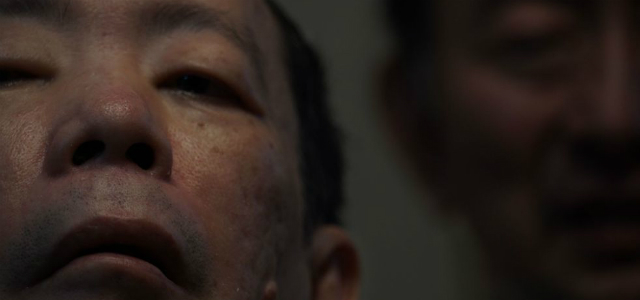
We Shall Not Forget: the lost films of 2017
In this season of awards and pantheonic enshrinement, Dr. Garth Twa remembers those films that were treated negligently, their merits left to fallow.
This year at the Vancouver International Film Festival and at the London Film Festival—and it happens every year—there were films that shone, or stunned, or made a profound impact. But now they are gone. What zeitgeist clockwork, what Jungian tides, lead some films to acclaim and Oscars—like, say, in recent years, Lenny Abrahamson’s The Room or Barry Jenkins’s Moonlight, and rightfully so—while others sink and die like a forgotten Tamagotchi? There are some superb films in contention for awards this year, but three of the year’s best have been forgotten: The Meyerwitz Stories (New and Selected), possibly Noah Baumbach’s best film; A Ghost Story, by David Lowery, which was sublime, and something actually new under the sun; and Good Time by Benny and Josh Safdie, which was joyful, heart-wrenching, ludicrous, and utterly charming.
Predominantly, major films in both festivals by the leading directors in world cinema today—The Square (Ruben Ostlund), Happy End (Michael Haneke), Loveless (Andrey Zvyagintsev), and, most of all, The Killing of a Sacred Deer (Yorgos Lanthimos)—torpedoed liberal complacencies and bourgeois self-satisfaction; nothing we like better than a little self-flagellation. I mean, European art film? What is that if not a liberal bastion? It is highly doubtful a Michael Haneke film will be filling the cineplexes of West Virginia (no offense, except, really, offense is fully intended). Who knows; perhaps there are more pressing targets in this time of rising global fascism, the threat to the democracy of the leading superpower, and a potential nuclear catastrophe as two despots—one a dictator, one a play-acting dictator, while another despot sits felinely smirking and licking his fangs on the Russian steppes—go head to head. Problem is, fascism is rarely funny.

The Killing of a Sacred Deer strode in and limped out without the panegyric it was rightfully due. The vivisection of liberal guilt and do-gooder compunction was mixed in with the penance and terror usually found in de Palma films or Pentecostal scripture. Actually, it was a bit de Palma, and a bit bible-y …or perhaps also a bit like Scorsese’s Cape Fear directed by Wes Anderson. I’ll stop that now. It’s reductive. But it’s hard, because he’s like this generation’s Luis Bunuel. But I will stop; Lanthimos is a rare, crystalline, and singular cinematic voice. The Killing of a Sacred Deer is a fable, an allegory, with all the revenge, families asunder, eyes for eyes, mysterious curses, and nubile princesses of a myth (the myth of Iphigenia being sacrificed to the goddess Artemis, to be precise). Steven Murphy (Colin Farrell), his wife, Anna (Nicole Kidman), and their two children (Sunny Suljic and Raffey Cassidy), are a perfectly nice and well-adjusted middle class family—Steven is a surgeon, Anna keeps their sex life alive by pretending she’s under general anesthetic, and both children have good hair. The characters speak with the emotional depth and vocal range of people still trying to get their dose of lithium right, and conversations and reactions are skewed as though in a dream, where extraordinary utterances are treated as mundane, and mundanities treated with undue solemnity. The placid family is soon decimated by the insertion of Martin (Barry Keoghan), a friend of Steven’s, and of uncertain provenance. What is the relationship—an esteemed heart surgeon and unmoored teenage boy? It seems a bit odd. Close but not affectionate, like a bastard from a bloodless tryst. Or perhaps a semi-reluctant experimentation with, you know, a catamite scenario, a Zeus-Ganymede sort of thing going on. At first Martin’s appearance seems anodyne, maybe even charitable on Steven’s part, but the insistent desperation becomes potentially fatal, in the way that witches with curses, or pissed off goddesses in ancient Greece, are fatal.
But this is Lanthimos, so unlike something more conventionally mythical or biblical (like, say, Paul Thomas Anderson’s Magnolia), there is no lesson to be learned, no mythic or biblical certitude. Steven is hardly deserving of the fate, really, and, in fact, it all seems a bit petty—what if Steven had ditched his family and hooked up with Martin’s mother? Would that have been all right? And who is Martin to be issuing curses, anyway? This is more like, “What if we had a myth, only filled it up with modern entitled assholes?” The plague wrought upon the house of Murphy doesn’t foment humility, guilt, or regret, but, instead, sibling squabbling and internecine positioning. It brings out the beast in the bourgeoisie.

A face of blasted, caustic, exhausted America—all that calls bullshit on the world.
Lucky by John Carroll Lynch gives us Harry Dean Stanton at his ripest, and, sadly, his last. He’s someone whose elements of appeal only got better with age (unlike, say, Brigitte Bardot or Kirk Cameron). His…charms… accrued, so at 93 he’s an even better Harry Dean Stanton than he was at, say 63. A face of blasted, caustic, exhausted America—all that calls bullshit on the world.
When David Bowie’s last album, Dark Star, came out, it was all the more poignant because it was a conscious farewell. The songs spoke of death and what that means. Lucky, too, is an elegy to its star. Everyone involved seems conscious of this—the filmmakers, the supporting cast, and especially Harry Dean Stanton himself. And like the bravery shown by David Bowie in confronting his own senescence, there’s courage here, too, in not flinching from the actual physical morbidity of age; the honesty and absence of vanity is startling. The film is unrushed; there’s time enough to say goodbye. The structure is episodic, like old friends showing up and offering eulogies, a round-robin of philosophy on dying. The tag team includes Ed Begley, Jr., playing his cranky doctor; and there’s Tom Skerritt, who last encountered Stanton over dinner on the Nostromo in Alien; and, of course, there’s David Lynch, there to muse over the existential conundrum of his AWOL tortoise. Those looking for the traditional comforts of a narrative arc, for the frissons of a plot twist or a sudden reveal will find little satisfaction here. The plot is character, the plot is place. It’s about the great horizontal that is America— backwater, high desert, lonesome highway America; the disappearing iconoclast, the disappearing frontier. It is the realm singularly occupied by Harry Dean Stanton. Whether he was in space or in Paris, Texas, he seems to be only able to exist in a desert. We lost something vital this year, but we have Lucky, and a simple and deliberate good-bye as Harry Dean Stanton looks directly through the lens at us and wryly smiles, nods, and walks away into the landscape.

There are some films that feel less watched than survived. Irreversible by Gaspar Noe, for one, or Salo by Pier Paolo Passolini, are stunning, devastating achievements, and wrenching to watch, which is not often a enticement for settling in to an evening of cinema. Films like that can stretch an audience’s fortitude. Personally, I find that watching them for the first time can cause a movie hangover, which must surely be some variant of PTSD. Caniba, by Lucian Castaing-Taylor and Verena Paravel, is like that. It was challenging to sit through—not many in the audience I saw it with at VIFF could—and, if you do make it to the end, you’re not certain if you’ve learned anything. Or if you did, you’re very, very uncomfortable with what you did learn. Castaing-Taylor and Paravel’s previous film, Leviathan, was similar in that respect. Leviathan was a poetic, hypnotic meditation on the North Atlantic fishing industry (though it was difficult to tell), and was more like video art than a documentary. It taught us nothing; it didn’t show us anything we might not have seen before, but it showed us a different way of seeing. That’s what made it extraordinary. And Caniba does no less. The subject this time is a self-confessed cannibal, Issei Sagawa, who killed and ate a woman in Paris. He was deported to Tokyo (he was never imprisoned in France because he was deemed insane) and put under the care of his brother, Jun. For almost all of its 90 minutes we are trapped in their small Tokyo apartment, with little but unnerving extreme close-ups, most of them out of focus. The extreme close-ups are not just visual but aural as well. For long stretches the talking heads (though usually it’s just mouths, or throats, or eyes that fill the screen) don’t even talk—they’re silent, but we still hear, in excruciating proximity, Issei swallowing and licking his lips.
It’s not often these days that I get to say I’ve never seen anything like this before. It used to happen a lot; the summer I discovered Fellini, for example, or the very first time I saw Pink Flamingos on a pirated VHS (that was another instance of Post Film Traumatic Stress Disorder, but in a good way). But with Caniba, I can honestly say I’ve never seen a film like this. Sometimes there may be a good reason for that. The film is haunting and insidious; when you leave the cinema it feels like it may have wormed its way under your skin somehow, became part of your DNA. With the lack of focus and lack of a sense of geography (we can’t see the environment, the room) we are ungrounded, unrooted, and the overly intimate close-ups draw us into Issei with little escape, and no breathing room—we can’t look away from those unblinking eyes that horrible, horrible sound of swallowing. The only release from the closeness are the cutaways to home sex videos that Issei has made, or to an escort he’s hired to feed him, who watches his mouth, mesmerized, as he chews, and to Jun, who has a sociopathy of his own and mutilates himself (also in extreme, unrelenting close-up). It says something that these moments come as a welcome relief.
Caniba is not for everyone, but the filmmakers have actually taken cinema to a place it’s never been before.

BPM (120 Beats Per Minute), directed by Robin Campillo, chronicles the onslaught of AIDS, which seems now, with the bulwark of decades between us, almost like science fiction. It came so suddenly, like a scythe through the nascent gay community, ripped apart communities and individuals from the inside, and no one knew what it was, where it came from, when it would stop. Campillo delves into the raw pain, the raw passions, the desperation, and the disgusting vilification of the victims as governments dragged their feet (in the States, Reagan refused to even mention it, choosing to treat it not like a health crisis but as a biblical punishment)—it was stigmatised as a gay plague which led to inaction which led to a pandemic. BPM is about the rise, through the carnage, of the activists of ACT UP who weren’t going lay down and die. The film, at first, is shot with the immediacy of a documentary, capturing the spontaneity of youthful anger and mordant humor, the infighting and infucking of young men and women given a death sentence, and the exuberance of the sad, frenzied dance that may be their last. It only gradually settles in on a relationship between Sean (Nahuel Perez Biscayart) and Nathan (Arnaud Valois), one infected, one not, and the poignant tragedy that they have found love only when it’s too late, and would never have been brought together if it hadn’t been for terminal circumstances.
This film is essential because we forget—there’s a generation, nearly two, who weren’t around for the devastation—what it was like: the bright vibrant young people who reveled in the freedom to love after centuries of hiding, institutionalisation, battery, abandonment, ostracisation, and the cruel irony of having finally been declared no longer a mental disease or a crime to be suddenly struck down by a plague of terrifying and humiliating virulence. Fit men and women, some in their early twenties, some in their teens, were demolished by rare infections and cancers that couldn’t even be diagnosed at first, diseases that ate the brain, that decimated their young bodies, leaving skin, bone, and lesions. Every week we lost at least one friend or lover. And, it seemed, nothing was being done about it. BPM does something about it: it remembers.






COMMENTS